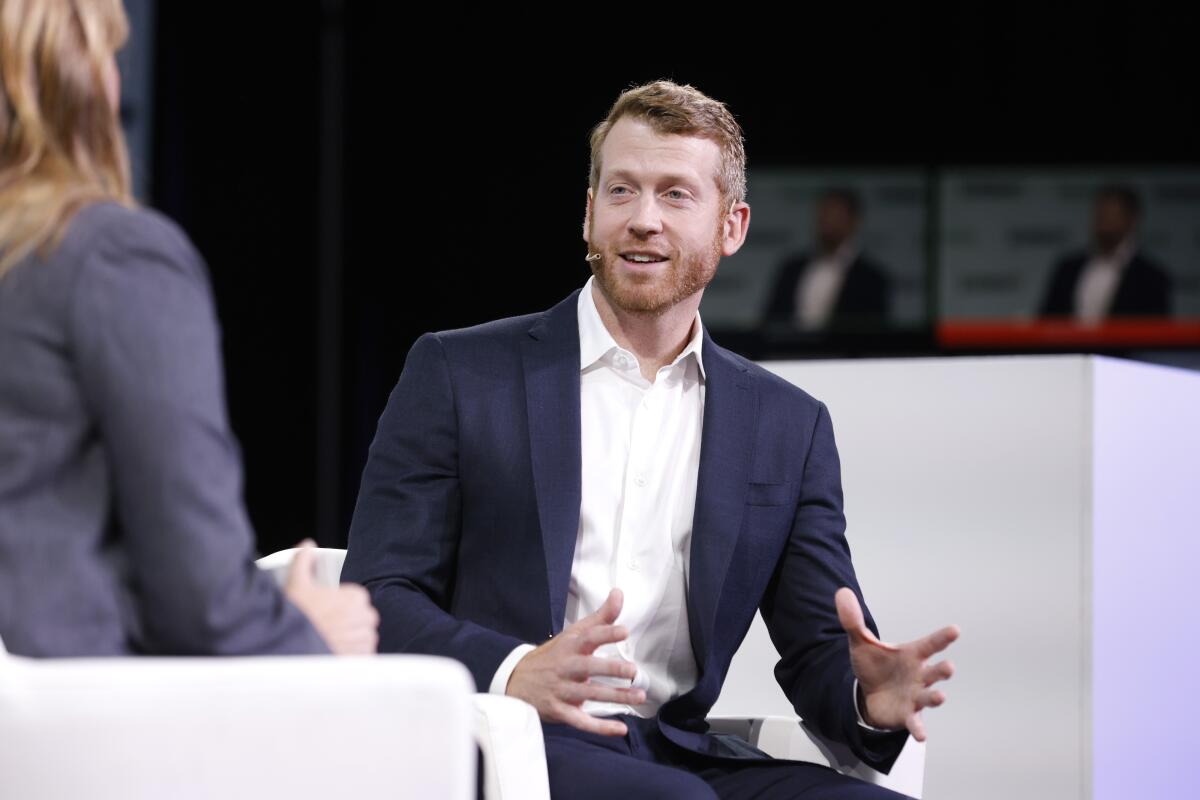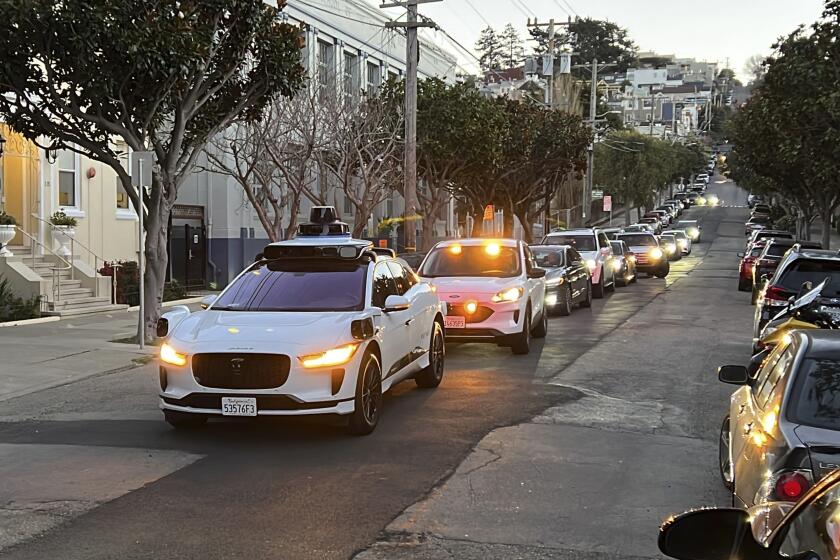A Cruise car hit a pedestrian. The company’s response could set back California’s new robotaxi industry

- Share via
On Oct. 2, a Cruise driverless robotaxi hit a woman in downtown San Francisco and pinned her under the car, sending her to the hospital with serious injuries.
On Tuesday, state authorities suspended Cruise’s operating permit, banning it from deploying driverless cars on public roads until safety concerns are resolved. The National Highway Traffic Safety Administration is investigating whether to take action too.
The turn of events marks a new chapter in the evolution of driverless cars and trucks. Not only is the underlying technology of autonomous vehicles under question; so too are the ethics of Cruise management, centering on founder and Chief Executive Kyle Vogt.
In pulling the permit, the California Department of Motor Vehicles cited safety concerns but also alleged that Cruise — owned by General Motors — misled the agency about basic facts.
What Cruise did not say, and what the DMV revealed Tuesday, is that after sitting still for an unspecified period of time, the robotaxi began moving forward at about 7 mph, dragging the woman with it for 20 feet.
The combination of safety and trust issues probably will deepen public skepticism about the technology and cause regulators to reevaluate their level of confidence in Cruise, if not the industry as a whole. That’s according to Bryant Walker Smith, an expert in automated vehicle law at the University of South Carolina. If Cruise can’t be trusted to be straightforward about the facts surrounding a serious injury case, “naturally the next question is how can we trust anything else you’ve told us.”
Here’s what happened: A car with a human behind the wheel hit a woman who was crossing the street against a red light at the intersection of 5th and Market Streets. The pedestrian slid over the hood and into the path of a Cruise robotaxi, with no human driver. She was pinned under the car, and was taken to a hospital.
Those were the facts that were publicized immediately after the incident. Cruise called the crash tragic but said that the robotaxi stopped as it was supposed to and that a human driver couldn’t have reacted any faster.
What Cruise did not say, and what the DMV revealed Tuesday, is that after sitting still for an unspecified period of time, the robotaxi began moving forward at about 7 mph, dragging the woman with it for 20 feet.
Cruise had shown a video of the incident to reporters but barred them from posting it publicly. (Because of that restriction, The Times turned down Cruise’s offer.) The video shown to reporters ended with the robotaxi sitting motionless. The video was edited and did not show the car start up and drag the woman 20 more feet.
The DMV said Cruise showed it the same abbreviated video, and only later did the agency see the full version. The two sides are fighting about that version of events. Cruise said it showed the DMV the full video from the start.
In any case, Smith said, “If Cruise did not show [reporters] the whole video or acknowledge that something else happened, that is not the truth, the whole truth, and nothing but the truth.”
He found Cruise’s withholding of the full clip “baffling,” because, he said, “of course that’s going to come out.”
As robotaxi companies plan to provide service in Los Angeles, San Francisco officials battle with state regulators over robotaxi safety.
Asked why the company did not show the pedestrian-dragging part of the video to reporters, Cruise spokesperson Hannah Lindow emailed this response: “We moved quickly to get information out to necessary parties, with our top priority being to ensure that all officials had access to the information they needed immediately to apprehend the criminal in this situation — the hit and run driver. Initial media reports stated that the Cruise vehicle initially struck the pedestrian and did not mention the hit-and-run driver that caused the incident. Additionally, first responders did not initially mention the hit-and-run driver. It was important to correct the record to show that the incident was initiated by a human-driven vehicle that fled the scene.”
Cruise and its competitor Waymo have been under fire for months for the tendency of their robotaxis to interfere with firefighters, emergency medical workers and police, to the point where the chief of the San Francisco Fire Department deemed them “not ready for prime time.”
At the time, the companies sought permission for a major expansion of their robotaxi services in San Francisco from the California Public Utilities Commission. Opponents asked the commission for a pause, recommending the emergency responder issue be resolved first. In August, the commission voted 3 to 1 to greenlight the expansion. One of the yes votes came from Commissioner John Reynolds, Cruise’s former corporate counsel, appointed by Gov. Gavin Newsom.
For Cruise, that plan for now has been dashed. After the vote, a Cruise vehicle crashed into a firetruck, and the company’s vehicles began to act in bizarre ways, clustering together to block pedestrian and vehicle traffic at busy intersections for no apparent reason. All that preceded the robot-drags-human incident and Cruise’s questionable response.
The repercussions could be huge, Smith said. “One possibility is that this feeds into the narrative of automated vehicles and the companies behind them are suffering and failing,” he said.
The other possibility is that “this becomes a moment of differentiation” separating the qualities of the various robotaxi companies in the eyes regulators and the general public.
Companies including Zoox, Motional and Waymo are taking a more deliberate and safety-conscious approach to their rollouts, he said. “Waymo, though not perfect, has been quite public and detailed about what safety means to them, in ways much better than Cruise.”
California should not blithely turn over public streets to Cruise, Waymo or other robotaxi companies to develop their autonomous vehicle businesses.
Los Angeles is currently considering how to handle an expected influx of robotaxis in the near future. One issue: The state has given cities no authority to regulate the technology, a restriction that had been pushed by industry lobbyists, and backed by Newsom.
Vogt often talks about safety as Cruise’s top concern: “The culture of Cruise and the sincerity with which we treat our values and behaviors is much higher than I’ve ever had in my career,” he told an audience at the Disrupt conference in San Francisco in September.
But he also emphasized the need to move fast. “San Francisco is a billion-dollar ride hailing market,” he said. “The scale is going to be very rapid. We are going to build thousands or maybe even more [vehicles] next year…. The goal is to get to scale as quickly as we can in terms of the total number of AVs to make this business profitable and sustainable.”
For now, Cruise is not moving at all.
More to Read
Inside the business of entertainment
The Wide Shot brings you news, analysis and insights on everything from streaming wars to production — and what it all means for the future.
You may occasionally receive promotional content from the Los Angeles Times.













